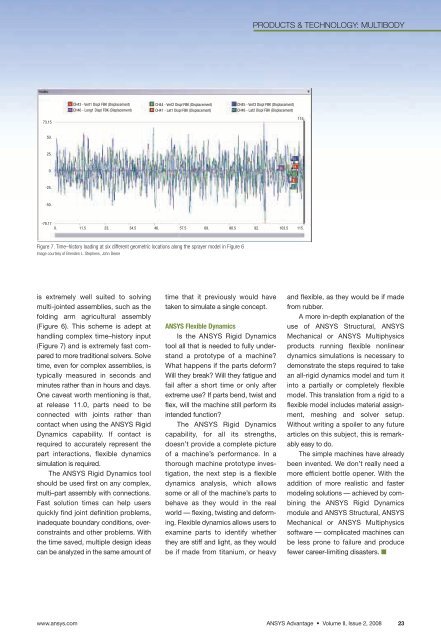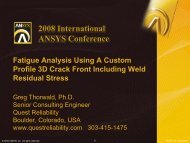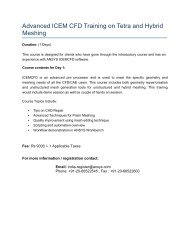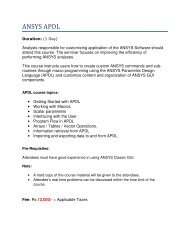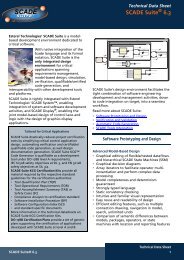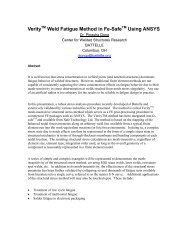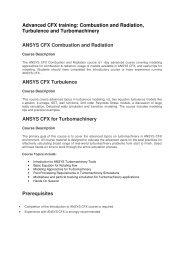Simulation - ANSYS
Simulation - ANSYS
Simulation - ANSYS
Create successful ePaper yourself
Turn your PDF publications into a flip-book with our unique Google optimized e-Paper software.
73.15<br />
50.<br />
25.<br />
0.<br />
-25.<br />
-50.<br />
CH43 - Vert1 Displ FBK (Displacement)<br />
CH46 - Long1 Displ FBK (Displacement)<br />
Figure 7. Time–history loading at six different geometric locations along the sprayer model in Figure 6<br />
Image courtesy of Brenden L. Stephens, John Deere<br />
is extremely well suited to solving<br />
multi-jointed assemblies, such as the<br />
folding arm agricultural assembly<br />
(Figure 6). This scheme is adept at<br />
handling complex time–history input<br />
(Figure 7) and is extremely fast compared<br />
to more traditional solvers. Solve<br />
time, even for complex assemblies, is<br />
typically measured in seconds and<br />
minutes rather than in hours and days.<br />
One caveat worth mentioning is that,<br />
at release 11.0, parts need to be<br />
connected with joints rather than<br />
contact when using the <strong>ANSYS</strong> Rigid<br />
Dynamics capability. If contact is<br />
required to accurately represent the<br />
part interactions, flexible dynamics<br />
simulation is required.<br />
The <strong>ANSYS</strong> Rigid Dynamics tool<br />
should be used first on any complex,<br />
multi–part assembly with connections.<br />
Fast solution times can help users<br />
quickly find joint definition problems,<br />
inadequate boundary conditions, overconstraints<br />
and other problems. With<br />
the time saved, multiple design ideas<br />
can be analyzed in the same amount of<br />
CH44 - Vert2 Displ FBK (Displacement)<br />
CH47 - Lat1 Displ FBK (Displacement)<br />
-78.17<br />
0. 11.5 23. 34.5 46. 57.5 69. 80.5 92. 103.5 115.<br />
time that it previously would have<br />
taken to simulate a single concept.<br />
<strong>ANSYS</strong> Flexible Dynamics<br />
Is the <strong>ANSYS</strong> Rigid Dynamics<br />
tool all that is needed to fully understand<br />
a prototype of a machine?<br />
What happens if the parts deform?<br />
Will they break? Will they fatigue and<br />
fail after a short time or only after<br />
extreme use? If parts bend, twist and<br />
flex, will the machine still perform its<br />
intended function?<br />
The <strong>ANSYS</strong> Rigid Dynamics<br />
capability, for all its strengths,<br />
doesn’t provide a complete picture<br />
of a machine’s performance. In a<br />
thorough machine prototype investigation,<br />
the next step is a flexible<br />
dynamics analysis, which allows<br />
some or all of the machine’s parts to<br />
behave as they would in the real<br />
world — flexing, twisting and deforming.<br />
Flexible dynamics allows users to<br />
examine parts to identify whether<br />
they are stiff and light, as they would<br />
be if made from titanium, or heavy<br />
PRODUCTS & TECHNOLOGY: MULTIBODY<br />
CH45 - Vert3 Displ FBK (Displacement)<br />
CH48 - Lat2 Displ FBK (Displacement)<br />
115.<br />
and flexible, as they would be if made<br />
from rubber.<br />
A more in-depth explanation of the<br />
use of <strong>ANSYS</strong> Structural, <strong>ANSYS</strong><br />
Mechanical or <strong>ANSYS</strong> Multiphysics<br />
products running flexible nonlinear<br />
dynamics simulations is necessary to<br />
demonstrate the steps required to take<br />
an all-rigid dynamics model and turn it<br />
into a partially or completely flexible<br />
model. This translation from a rigid to a<br />
flexible model includes material assignment,<br />
meshing and solver setup.<br />
Without writing a spoiler to any future<br />
articles on this subject, this is remarkably<br />
easy to do.<br />
The simple machines have already<br />
been invented. We don’t really need a<br />
more efficient bottle opener. With the<br />
addition of more realistic and faster<br />
modeling solutions — achieved by combining<br />
the <strong>ANSYS</strong> Rigid Dynamics<br />
module and <strong>ANSYS</strong> Structural, <strong>ANSYS</strong><br />
Mechanical or <strong>ANSYS</strong> Multiphysics<br />
software — complicated machines can<br />
be less prone to failure and produce<br />
fewer career-limiting disasters. ■<br />
www.ansys.com <strong>ANSYS</strong> Advantage • Volume II, Issue 2, 2008 23


